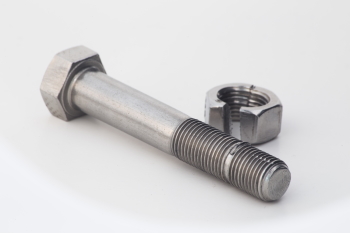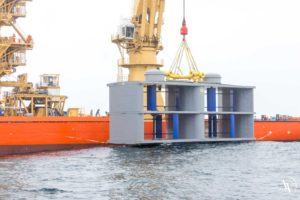Galling Is a Serious Issue in Water Treatment – But There Are Solutions

Galling is a serious issue in water treatment (Image source: BUMAX AB)
With potentially disastrous effects resulting from galled fasteners seizing or even being subject to a fatigue breakage, the waste and water treatment industry players are advised to counter this threat.
Not everyone in the water treatment industry is familiar with the concept of galling, except for those who absolutely must know: designers and engineers. Other may only become aware when an expensive machine breaks down. With galling posing a serious threat to the quality and safety of expensive and crucial machinery and production equipment, staff in executive management, operations and procurement would be wise to also study this phenomenon.
Galling is a common form of mechanical wear caused by excessive friction between two moving surfaces, usually metal surfaces. The process involves material being torn up and transferred between the two surfaces when they are under sufficient load that compress the surfaces together.
Standard stainless steel fasteners are prone to galling
Standard stainless steel bolts and fasteners have a tendency to gall under certain conditions due to their specific properties. Thread galling can occur with standard fasteners when pressure and friction cause the bolt threads to seize to the threads of a nut or a tapped hole. Severe galling, known as “cold welding”, can cause the two surfaces to fuse together, which makes the joint impossible to remove without cutting the bolt or splitting the nut.
The consequences and implications of galling should not be underestimated. A galled fastener may not be able to achieve the necessary pre-load – especially in case of dynamic loading. This jeopardizes the entire reason for using fasteners, i.e. to securely fasten two surfaces together, which is complicated by the fact that an application may involve hundreds or even thousands of stainless steel fasteners.
Imagine critical fasteners in the rotating parts of a chemical pump or propeller galling. The joint is likely to be subject to a fatigue breakage, which will at least require costly maintenance and downtime for the customer or end-user. However, in the worst-case scenario, the fatigue breakage of critical fasteners can have serious safety implications that might result in accident or injury. Galled fasteners are also much more susceptible to corrosion, which can ultimately result in breakages.
Risk of catastrophic failures
Galling is an issue in many segments and applications, wherever stainless steel fasteners are used. Looking at the water treatment industry, there is a risk of catastrophic failures if the thread galls before sufficient torque has been obtained. That covers most if not all machines and devices with moving parts, for treatment purposes. Even a simple water pump needs a premium fastener like the BUMAX 88 with a high molybdenum content that makes the joints extra strong, reliable and corrosion resistant. In extreme cases, galling can lead to the fastener breaking and failure of the application. The risk is highest for applications that are exposed to dynamic loads.
However, galling can be overcome even in the most challenging of applications – particularly by selecting premium quality stainless steel fasteners.
How can galling be prevented?
It is important to consider how galling can be avoided from the outset when designing a particular fastener application in order to avoid a great deal of rework, maintenance and costs further down the line. Basically, to minimize galling and its negative consequences, it is essential to be aware of the concept of galling and ensure that only premium stainless steel fasteners are used in critical applications.
Premium fasteners may look similar to standard stainless steel fasteners, but their superior material properties can make all the difference with galling. Explain to your fastener supplier exactly how the fasteners will be used to ensure you optimize galling resistance. Premium stainless steel fasteners also typically offer other properties that are essential in many critical fastener applications – including corrosion resistance and high tensile strength.
The benefits of greater galling resistance
Using premium fasteners that are at a lower risk of galling brings the following general benefits:
- Less maintenance, stoppages and other production disturbances. Most machines used in production are designed to clock up thousands of hours of “work” with very little downtime. Any downtime can be very costly in terms of repairs and lost operational revenues.
- Increased safety and security. If a fastener malfunctions or breaks, the result can be dangerous and even disastrous, depending on the application. Just imagine a weakened vehicle, vessel or building…
- Increased cost-effectiveness. Using the best fasteners from the very start can save a lot of money down the line. The extra cost for premium fasteners pales in comparison to repair and replacement costs.
Besides choosing the correct fasteners, there are other preventative measures to take:
#1 Correct material selection
Selecting the correct material for a specific application is extremely important as certain types of stainless steel are more prone to galling due to their atomic structure. In particular, strain-hardened stainless steels that have been cold formed provide excellent galling resistance due to their improved strength and reduced ductility.
#2 Choosing fasteners with a perfect fit
As galling is common between metal surfaces that are in sliding contact with each other, premium fasteners that are designed to perfectly fit together can significantly reduce the risk of galling as they minimize movement and friction. Here, high-quality threads with less surface deviations that can rub together and lead to galling issues are particularly essential.
#3 Lubrication
Lubrication is an important way to reduce galling by allowing the two materials to slide past each other without causing friction. Some leading premium fastener manufacturers use custom-made wax to ensure an optimal friction coefficient. Anti-seizing and anti-galling lubricants can also help reduce galling.
#4 Not using damaged fasteners
A bolt with dented or damaged threads has a significantly increased chance of galling. All fasteners must be checked for damage that may have occurred during shipping. Dirty bolts with debris in the threads can also greatly increase the risk of galling – so only clean bolts should be used.
#5 Careful installation
As most stainless steel is more sensitive to high temperatures, tightening bolts more slowly can reduce friction and heat that can cause galling. This may involve avoiding the use of power tools that can cause excessive friction and heat. Calculations should be made for particular applications to determine the kind of tools that can be used.
Decision makers must ask theirselves: How valuable are the water treatment assets? Is it worth gambling on cheaper, galling-prone fasteners and bolts rather than premium stainless steel fasteners that are specifically developed to minimize galling? Water treatment industry executives must be aware of the potentially disastrous implications of fasteners failing due to galling, and do their utmost to prevent this from happening. This cannot be left to chance.
Source: BUMAX AB







